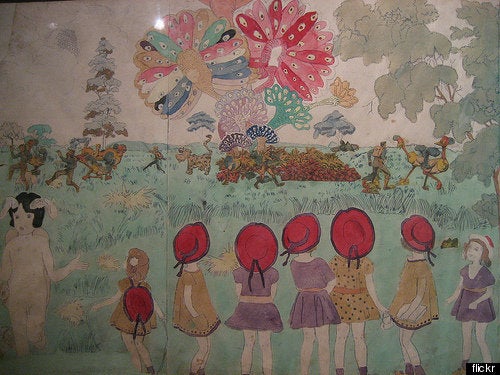
I was very happily surprised in New York last week to see an example of "art brut" or outsider art -- a piece by Henry Darger -- hanging alongside works by Beuys and other "mainstream" artists who are well appreciated by the "official" art market. In a period of three days I saw Darger's Vivian girls in the Andrew Edlin Gallery on the lower West Side, at MOMA, in the Judith Rothschild collection, and at the American Museum of Folk Art.
The recently published book, "Henry Darger" by Klaus Biesenbach (of MOMA and PS1), which features essays by Brooke Davis Anderson of the Museum of American Folk Art, Michael Bonesteel of the Art Institute of Chicago and Carl Watson, whose doctoral dissertation is on Darger's "The history of my life", is what Darger enthusiasts have been waiting for...a kind of "complete" Darger work, a weighty book which offers the most collection of images of Darger's work, linking it to economic meltdowns, male and human isolation, and contemporary works by the likes of the Chapmans and Rineke Dijkstra. Earlier last month, while in London, attending Frieze, I learned about the opening of a fantastic new museum, The Museum of Everything, dedicated to Outsider art, with numerous Dargers included alongside some of my favorites, Widener and Aloise. But what struck me the most was that Bloomberg's newly designated "man #1 in the art world" -- Hans Ullrich Obrist -- listed the opening of the Museum of Everything as one of the most interesting exhibits, even giving a talk on an outsider artist from his native Switzerland, Hans Krusi.
My discovery of art brut began in Paris in the rue de Charenton in 1987, in an apartment I had sublet from a Psychoanalyst who had posters of art brut exhibitions of the work of the Swiss artist, Adolf Wolfli hanging in the living room. One evening when a Swiss friend came to visit, he started speaking about his home town of Bern's collection of Wolfli's works and how his psychiatrist father had studied them. I had never heard of Wolfli nor of art brut. I then made a trip to Bern to see the rooms full of Wolfli's works. And that began what became almost an obsession for me with art brut.
The term "art brut" was coined by the artist Jean Dubuffet who was inspired by these works made by self-taught artists, who remained removed from the commercial art market. His collection became the basis for the magnificent Musee de l'art brut in Lausanne. Twenty years later, also in the rue de Charenton in Paris, I discovered the art brut gallery operated by Christian Oberst, La galerie d'objet trouve. Next year the museum in Lille will open an art brut wing, and collectors are catching on fast.
I grew up in Houston. The South has a lot of outsider art, perhaps because it has always had its fair share of eccentrics, but also because of a strong influence of religion and other experiences which entailed more outside than inside in terms of acceptance by the formal art community. One of my best friends growing up has a mother with what can only be called an Outsider art collection, and I grew up seeing this work alongside more well known and more expensive contemporary artists' works. My mother was a painter and a psychotherapist who painted her dreams -- so it was only normal that I would equate art with therapeutic and healing qualities of self-expression. She brought me to the Fine Arts Museum and Museum of Contemporary Art and later to the Menil Collection again and again. I never understood why an expensive Twombly or Rothko sold for more than a work by outsider artists. They seemed to all be reaching for the same thing -- some kind of authenticity -- a word many avoid when describing not only art, but, well...anything anymore. Maybe I am naive, but I could never imagine Twombly or Rothko or Joseph Cornell really giving a damn about the art market. They created because they had to. Period.
When I turned forty all I wanted was a piece by Henry Darger, a Vivian girl in honor of...well, being Vivian. When my then boyfriend asked me what I wanted I asked for the prices, but thought a Darger was too much to ask for. A few years later, when the value of the dollar fell, I finally bought one for myself. Along with my books, family photos and a few great dresses, my daughter will inherit a few works by artists I have come to treasure. These are so-called "marginal" people who created rich inner worlds even while the world outside them was going crazy. And they didn't give a damn what anyone thought of what they created.
For me, that is true art. It exists because it cannot not exist. The artist becomes a kind of healer/shaman; and we, those who finally have access to these miraculous pieces, become initiated into worlds which take us places we have never been before. That, for me, is creativity. It has nothing to do with putting a price on things, but rather the inner worlds of those who touch us in ways which make us truly human. I am not surprised by the research which shows that Outsider art flourishes in times of financial crisis when we are searching for real meaning and truth, not consumerist pre-packaged notions of what should be appreciated or is of value.